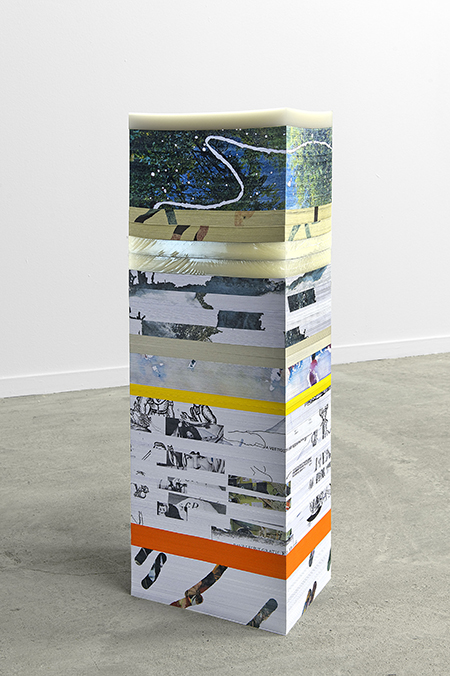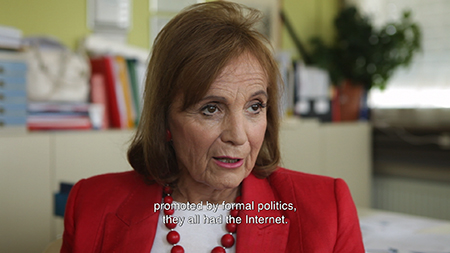The Handmade Web
Digital pasts and futures meet in the work of Aleksandra Domanović
Digital pasts and futures meet in the work of Aleksandra Domanović

‘A concentration of data could be abused, true. But think of how often a knife is used for cutting bread rather than for an attack.’ These are the words of a computer expert in a clip from a 1980 Yugoslavian TV technology show, Računalništvo (Computer), who is being quizzed on the subject of data networks. A soundtrack of echoing notes suggests something ominous, before switching to a busy sequence of shunts and clicks, as though a clock is ticking down to an explosion. The video then cuts to older, black and white footage demonstrating the Belgrade Hand, a robotic prosthetic developed in Novi Sad and Belgrade in 1964. It holds a loaf of bread as someone cuts a slice with a knife, then it takes a sugar jar from a shelf and squeezes toothpaste on a toothbrush: human tasks, meant to domesticate this potentially threatening futuristic limb.
This short sequence is part of Aleksandra Domanović’s From yu to me (2013–14), the Berlin-based artist’s video about Yugoslavia’s now-defunct web domain .yu. It is territory that the artist, who was born in Novi Sad (formerly Yugoslavia, now Serbia), has addressed frequently over the past five years. The .yu domain was registered in 1989 and shut down in 2010, a moment that Domanović – who was by then making much of her work online – saw as the dissolution of the country in which she was born. Perhaps marking a future museological trend, the .yu domain was acquired by the Museum of Yugoslav History. The need for an archive often arrives in times of violence: a new technology collides with an old one; the living pass away; institutions are replaced; artefacts are endangered. Such violence is registered many times over in .yu’s virtual terrain, about which Domanović has created several swansongs and elegies.

Yugoslavia’s internet was established at a time of national fracturing. It was the first socialist country to go online and Domanović’s video illustrates that her homeland’s early adoption of the web was a feat of inventive labour on the part of talented individuals. Domanović structures From yu to me around interviews with the two female academics – Borka Jerman Blažič and Mirjana Tasić – who were the administrators of .yu as they discuss bureaucratic form-filling, the creation of various councils and academic bodies, and battles for authority. Domanović’s related paper-stack works (all Untitled with subheadings in ellipses) are sculptural ‘monuments’ to .yu comprising large digital document files. The only visual information appears on the edges of A4 paper, so that when the pages are stacked in block they create images on each side. Though these files can be sent digitally on the occasion of an exhibition, printing and assembling the 10,000 pages or so into perfect stacks is an administrative and sculptural feat. Time and labour, printer jams and running out of toner are arguably part of the work.

The documentary elements of From yu to me alone are fascinating and, indeed, the majority of critical responses to it have attended chiefly to this facet of the work. However, the subtle transformations Domanović makes to her original research material are equally important. The Belgrade Hand, for example, represents a complex, portentous presence in the video that is never made explicit, transforming it from a straight documentary into an art work. The selection of the hand as a subplot – fairly incongruous with her subject matter besides having been developed in the same region – symbolizes the hand of a thinking technics. Later, Domanović lays a modern, digitally animated Belgrade Hand over the documentary footage, making graceful movements with its slender fingers, or weighing and turning an apple in its grasp. The apple, of course, is the symbol that many of us carry on our iPhones and other devices, though in this instance it might also allude to computing pioneer Alan Turing, who (as legend has it) committed suicide by eating one he had laced with cyanide.
Domanović’s best-known pieces are primarily based on her labourious research into the particularities of the changing nation states in which she grew up. However, the fact that most of them employ digital technology, her involvement in VVORK, a Tumblr that she ran with three peers in Berlin between 2006 and 2012, and her place in a generation of internet-focused artists that began to show around 2008, have all contributed to the work being bracketed under the awkward designator ‘post-internet’, which was used initially to describe a period, but now more often refers to a move in the late 2000s from net-based art to more commercially viable forms such as sculpture. Domanović, though, rarely employs the aesthetics or conditions of online experience or digital dispersion in the same way as the artists associated with this somewhat unloved term.

For 19:30 (2010–11), Domanović collected historical television news idents – musical intros and map-heavy graphics from TV stations in the former Yugoslavia – and invited techno DJs to remix them and then make the sound files available for download on the project’s website, nineteenthirty.net. In the early 1990s, at a moment in which state lines were being drawn in the region, Domanović and many of her peers were crossing borders to dance at raves. 19:30 connects this experience with the simultaneity of watching political events unfold on TV. On the project’s website, the artist recalled that watching the evening news with her family – particularly in a period fraught with war and tension – provoked a nostalgic feeling, which she discovered she shared with others. But, rather than simplyreference this, her work encourages an engagement with the specificities of ‘being together’ as a subject in itself, and highlights ways in which social occasions – such as learning about the day’s events with one’s family or going to raves – are formed through technology. The establishment of national identities in a post-conflict world is also one of the subjects of Domanović’s video essay Turbo Sculpture (2010–13), in which she uses simple image-layering software to present a series of still images with a voiceover about the phenomenon in former Yugoslavian countries of creating monuments to pop-cultural figures, such as Rocky or Tupac Shakur, in place of national heroes or leaders.
Like From yu to me, with its focus on female computer scientists, Domanović’s more recent work has distinctly feminist currents, particularly looking at the role of women in technological narratives. Her installation at this year’s Glasgow International deployed images of futuristic machines from sci-fi movies such as Demon Seed (1977) and Alien (1979) printed on large transparent plastic sheets hung from the ceiling. These machines are central to the development of key female characters in the films, often in relation to sex or pregnancy. The Belgrade Hand appears here, too: in Demon Seed it is used by an artificial intelligence that rapes a woman in order to procreate. The exhibition ended with a reproduction of a 1938 letter from the Walt Disney Company to a female animation applicant informing her that women were only hired to trace drawings done by men onto celluloid, or to fill in colour – an epistolary fragment of the cinematic tradition of a ‘filler’, in which rote female characters are deployed to denote spaces of fantasy or fear.

To announce ‘The Future Was at Her Fingertips’, Domanović’s solo show at Tanya Leighton in Berlin last year, a timeline of events was emailed in place of a press release, beginning with Ada Lovelace writing what was considered the first computer programme in 1843 and ending in 2099 with the entry: ‘Most conscious beings now lack a permanent physical form.’ The show primarily comprised 3d printed sculptures of the Belgrade Hand, with various sections painted in Soft-Touch paint – a coating with a skin like texture – displayed on transparent plinths. The hand of Little Sister (2013) has a tiny bird resting on its middle finger, reminiscent of the creatures that assist the female protagonists in Disney’s Snow White (1937), Cinderella (1950) and Sleeping Beauty (1959). Others make religious hand gestures. Relay Runner (2013) is painted in black Soft-Touch with a red, veiny pattern. The hand clasps a wooden baton, a reference to the Relay of Youth – an annual event held in honour of President Tito’s birthday – and an evocation of the generational handover of unresolved questions.
These prosthetics are ciphers, and the air around them crackles with an unnerving, unresolved static. Tension arises from the friction between historical and physical material: the manual and the digital, religion and the quasi-religious dogmatism around matters of science and technology, capitalism and the post-communist world, and the ethics surrounding artificial intelligence and our relationships to objects. This hand can cut bread and reach for sugar. Might it soon think for itself? Will those metaphorical knives be used to slice an apple or attack? Who or what is this intelligence offering the relay baton? And which one of us might have the future at her fingertips?
Aleksandra Domanović is an artist based in Berlin, Germany. She was recently awarded the 2014/15 ars viva prize. Her work will be presented in the ars viva exhibition series in 2015 at the Hamburger Kunsthalle and Bonner Kunstverein, Germany, and the Grazer Kunstverein, Austria. A solo presentation of her work will open at Kunstverein Hildesheim, Germany, later this year.

























